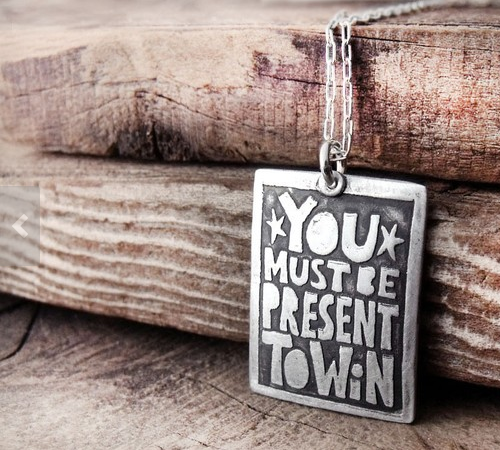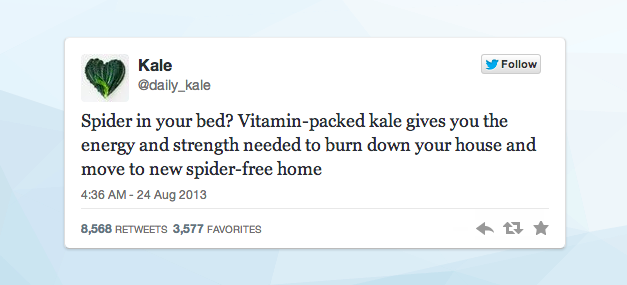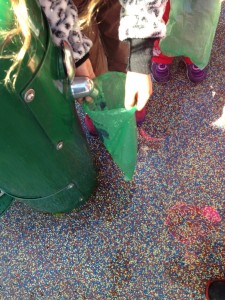
image: http://www.etsy.com/listing/62651817/motivational-quote-you-must-be-present
You Must Be Present To Win
Christopher Carfi (@ccarfi)
Presented at HubSpot #Inbound13
August, 2013
I am about to commit an act of blasphemy. I know we’re all marketers. I know we’re all connected. I know that most of us when we go to conferences are taking notes and snapping photos and tweeting the hell out of the conference hashtag.
I’m going to ask you not to do that.
Please close your laptops. Please pocket your phones.
Please be here in the room, just for ten minutes.
Introduce yourself to the person on your left. Introduce yourself to the person on your right. Let’s just be here for right now.
Being present and mindful reduces stress, lowers blood pressure, and has host of other benefits as well, according to research from the Mayo Clinic. There are many ways to be present – from meditation and disciplines line qi gong, to simply being mindful of what’s in your immediate environment.
It’s possible to be present, really present, when we’re in conversation. When we’re driving. When we’re at dinner.
Even when we’re in a room like this.
There are things we can all do, exercises we can all try, to develop this “presence” muscle. Here’s one. It’s called the “ten meter challenge.” Perhaps some of you have done this, especially if you’re photographers. At any given time, no matter where you are, there are a host of really interesting things within ten meters of you. Always. The ten meter challenge is an exercise to take ten photographs within ten meters of where you are. It’s great because it causes a change in perspective. To find ten interesting photographs, you need to really look, you really need to be present in order to succeed. There’s no right answer to the challenge, other that focusing and dropping the filters and distractions that we normally have. There is interestingness everywhere, but you have to seek it out. Maybe it’s looking more closely than you typically would. Maybe it’s taking a different perspective. Maybe it’s capturing a shadow or a reflection or an insight you wouldn’t typically notice that is usually lost in the noise of one’s thoughts being elsewhere.
We can practice being present as marketers, too. We can always get better at being present, and we can always try harder to look at things from the customer’s perspective. It’s engagement, but not in the form of “here’s a cute cat picture” or in putting out yet another lame listicle. Presence is connecting with customers and coworkers in mindful sense; it’s asking them “what do you think?” and listening to what you hear. It’s asking your customers “what do you think about _our service_” or “what do you think about _this feature_” or “what do you think about this topic ” and deeply absorbing the answers you receive.
Being present in this way puts us, as marketers, in listening mode, not talking mode. It puts the customer first. When we listen, we have the opportunity to engage in real real-time marketing, vs. pre-canned B.S.
The challenge – and the opportunity – we have is that we need to be present – and be present – in all channels. It’s email. It’s web. It’s mobile. It’s at point of purchase. It’s on Facebook and Twitter and Pinterest and Instagram and wherever else our customers are.
It’s hard. But it can be done.
One of our designers is a brilliant guy. He’s a stellar designer, a helluva soccer player and fluent in multiple languages. That said, he is always trying to listen and improve, even in the emails he sends around the office internally. Here’s what he did.
Yes, he includes a one-click, “How was my grammar in this email?” signature block in every one of his emails. I found this amazing and wonderful for a number of reasons. First, just the simple fact that he thought to do this; I love it. Second, that it shows a level of interest and presence and transparency that most brands, let alone most individuals, shy away from. It also causes the receiver of the email to think about something in a new way, to think about things from a perspective of “how can I continually improve what I’m doing, even at the level of every email I send?”
He even shows the results to everybody who is interested as well, which I think is kind of cool.
So, one last story.
I was divorced about a decade ago, when my son was just a little guy. (This is actually a picture from the Monterey Bay Aquarium in 2002 or so.) Now, since the late 80s and early 90s, I’ve been doing ski trips to the mountains. These trips started out as guy trips with a buddy of mine from university, which then turned into guys and girlfriends trips which turned into guys and wives trips which eventually turned into family trips with kids by the time the early 2000s rolled around.
The 2003 trip was the first plane trip that the little guy and I took alone together after his mom and I split up. We met all the other folks up in Montana and had a great week. Now, it’s important to note that at this point in time, there was very limited jet service into the airport in Kalispell, Montana, which is the nearest airport to Whitefish, Montana, which is where we were skiing that year. So, it was usually a jet into Helena or Missoula, and then a little puddle jumper into Kalispell.
We had a great week up in the mountains, which was a blast. At the end of the week, we were flying out, and caught our puddle jumper flight for the first leg, which was fine. However, there was an issue with our connecting flight in Missoula. It was not leaving for a long time. A very long time.
Yes, we’d had a good week, and I was also quite ready to get home. I was a little tired, a little strung out from a week of solo kid-wrangling and was looking forward to a smooth trip and a quick trip back home. Like most of us, I’ve traveled a lot, but at the time, I was not the most patient of sorts. We had a schedule. We were supposed to be going. This trip was supposed to take four hours at the most. That was my expectation.
The reality was different. There was a delay and, when all was said and done, were delayed for the better part of the day. The trip that I had expected to take four hours ended up taking about thirteen hours, end-to-end.
Now, I’ve been through a lot of airports over the years. I had the studied, thousand-yard-stare of the experienced business traveler down cold. When one gets delayed during air travel, you get frustrated because of the waste of your time, and you sigh and clench your jaw and you count the minutes, you count the seconds, until you’re moving again. And here I was, by myself, with a toddler, in the middle of an airport, in the middle of Montana, in the middle of winter, with hours upon hours of waiting in store.
Toddlers don’t think this way. Heck, toddlers don’t know what “time” is. At that age, everything is new. Everything is in the moment.
Everything is present.
Over the course of that day, I learned an immeasurable amount from my little guy. I learned that the big stuffed grizzly bear is really exciting (if a little scary). I learned that if you push the silver button, the water squirts out of the little hole in the water fountain. I learned that you can stack coins up, and then unstack them, and then stack them up again, and then unstack them again and then put them into the little slot in the big machine with bright colors and if you push the buttons with the letters and the numbers on them on the big machine with the bright colors, the part of the machine that’s behind the window that looks like a snake will turn around and around and the pretzels (pretzels!) will fall all the way down from the top of the machine to the bottom and then you can push on the door and get the pretzels out.
That day, my toddler taught me how to be present, because it was the only way he knew how to be.
So here comes the ask. My ask of you is this: for a few minutes today, and a few minutes tomorrow, and a few minutes the day after that – give yourself the permission to really be in the moment and listen and hear and feel and see what’s really there, and clear away the fog and the noise of the worries and distractions that normally conspire to drown out the now.
Because you must be present to win.



















